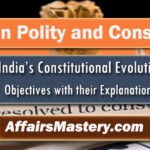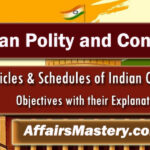Set 8 | Important Indian Constitution Evolution MCQs
Important Indian Constitution Evolution MCQs. The way the Indian Constitution has evolved over time plays a huge role in shaping Indian Polity and Governance, and it’s one of those things that really lays the groundwork for doing well in competitive exams—whether it’s Civil Services, State exams, SSC, Railways, Banking, or any of the others out there. Diving deep into Indian Polity, Constitution, and governance isn’t just about memorizing facts or ticking boxes for exams, but more about developing the kind of awareness that can make navigating these challenging exams a little less overwhelming and a lot more manageable.
| MCQs on Indian Constitution Evolution – Objective Questions and Answers |

Q71. Who was the President of the Indian National Congress at the time of partition of India? (65th B.P.S.C. (Pre) 2019)
[A] J.B. Kripalani
[B] Jawaharlal Nehru
[C] Maulana Abul Kalam Azad
[D] C. Rajagopalachari
[E] None of the above/More than one of the above
View Explanation
Correct Answer is A.
- [A] The President of the Indian National Congress at the time of the partition of India (1947) was J.B. Kripalani.
- [B] Jawaharlal Nehru – He was not the Congress President at that time but became the first Prime Minister of independent India in 1947.
- [C] Maulana Abul Kalam Azad – He was the Congress President before Kripalani, from 1940 to 1946, and played a key role in the freedom movement.
- [D] C. Rajagopalachari – He was the last Governor-General of India but was not the Congress President during partition.
Q72. “In their nationalist reaction, the Founding Fathers of Indian Constitution tended to minimize the importance of minority interests and emotions.” (U.P.P.C.S. (Spl) (Mains) 2004)
This view is credited to:
[A] Morris Jones
[B] Hardgrave Junior
[C] Alexandrovitz
[D] Ivor Jennings
View Explanation
Correct Answer is D.
- This particular remark about how the makers of the Indian Constitution, in their nationalist approach, ended up downplaying the concerns and emotions of minorities was actually made by Sir Ivor Jennings.
- He was the one who commented on the provisions related to minority protection in the Indian Constitution. His observation pointed towards how, while drafting the Constitution, the leaders were more focused on unity and nation-building, which, in a way, led to giving less priority to the specific interests of minority communities.
Q73. “Constituent Assembly was Congress and Congress was India” who said this? (U.P.U.D.A./L.D.A. (Pre) 2013)
[A] Austin
[B] C.R. Attlee
[C] Winston Churchill
[D] Lord Mountbatten
View Explanation
Correct Answer is A.
- The well-known historian Granville Austin once made a statement where he said that the Constituent Assembly and the Congress were basically the same, and the Congress itself represented India.
- His words highlighted how deeply the Congress was involved in shaping the Constitution and how, during that time, it was seen as the main force speaking for the country.
Q74. Who said ‘India is a Quasi-Federal State’? (U.P.P.C.S. (Pre) 2019)
[A] Lord Bryce
[B] Ivor Jennings
[C] H.J. Laski
[D] K.C. Wheare
View Explanation
Correct Answer is D.
- The concept of India being a “Quasi-Federal State” was given by K.C. Wheare.
- He described India as having federal features but with a strong centralizing tendency, making it not a purely federal but a quasi-federal system.
Q75. Who in the beginning, presented the idea of Indian Constituent Assembly in pre independence days? (U.P.P.S.C. (GIC) 2017)
[A] M.N. Roy
[B] B.R. Ambedkar
[C] Ani Beasant
[D] Jawaharlal Nehru
View Explanation
Correct Answer is A.
- The idea of an Indian Constituent Assembly was first proposed in pre-independence days by M.N. Roy in 1934.
- He was a radical thinker and one of the first to advocate for a constitution drafted by the people of India rather than imposed by the British. Later, the demand was taken up by the Indian National Congress and other leaders.
Q76. How many women members were there in the Indian Constituent Assembly? (U.P.P.S.C. (R.I.) 2014)
[A] 15
[B] 13
[C] 12
[D] 10
View Explanation
Correct Answer is A.
List of 15 women members of the Indian Constituent Assembly who contributed to drafting the Indian Constitution:
- Sarojini Naidu
- Vijaya Lakshmi Pandit
- Rajkumari Amrit Kaur
- Durgabai Deshmukh
- Hansa Jivraj Mehta
- Sucheta Kripalani
- Renuka Ray
- Purnima Banerjee
- Kamla Chaudhary
- Leela Roy
- Malati Choudhury
- Annie Mascarene
- Begum Aizaz Rasul (the only Muslim woman in the Assembly)
- Dakshayani Velayudhan (the only Dalit woman in the Assembly)
- Madam Bhikaji Cama (although often mentioned in discussions about women in the freedom movement, her formal role in the Constituent Assembly is debated)
Q77. Who speaks of India’s self-reliant social system ‘The rural system in India is a tiny Republic’? (M.P.P.C.S. (Pre) 2020)
[A] Charles Metcalfe
[B] Burke
[C] Mill
[D] Cunningham
View Explanation
Correct Answer is A.
- The statement that “The rural system in India is a tiny Republic”, referring to India’s self-reliant village communities, was made by Charles Metcalfe. He praised the Indian village system for its ability to sustain itself despite political changes.
Q78. The States and the Central Government derive power from (M.P.P.C.S. (Pre) 2017)
[A] The Constitution of India
[B] The president of India
[C] The Prime Minister of India
[D] The Parliament of India
View Explanation
Correct Answer is A.
- In India, both the States and the Central Government derive their powers from the Constitution of India, which is the supreme law of the land. It defines the structure, functions, and powers of both levels of government.
Related articles:
- Set 1 | Important Indian Constitution Evolution
- Set 2 | Important Indian Constitution Evolution
- Set 3 | Important Indian Constitution Evolution
- Set 4 | Important Indian Constitution Evolution
- Set 5 | Important Indian Constitution Evolution
- Set 6 | Important Indian Constitution Evolution
- Set 7 | Important Indian Constitution Evolution



